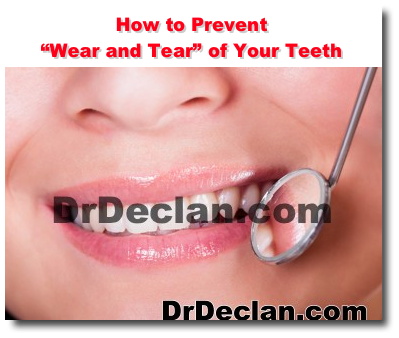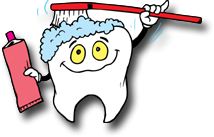How to Prevent "Wear and Tear" of Your Teeth
- Tweet

Authors: Dr. David Matto and Dr. Declan Devereux
 Many of our patients notice that they have holes or grooves in their teeth. Some patients point to the biting surface of their teeth and ask why there's a concavity. Other patients point to the side of their teeth or run their finger nail in the groove by the gum line. These "grooves" or "notches" in the teeth by the gum line may or may not be sensitive. Patients also notice that these areas often appear more yellow in color in comparison to the rest of the tooth. They often ask if we can whiten or bleach this area.
Many of our patients notice that they have holes or grooves in their teeth. Some patients point to the biting surface of their teeth and ask why there's a concavity. Other patients point to the side of their teeth or run their finger nail in the groove by the gum line. These "grooves" or "notches" in the teeth by the gum line may or may not be sensitive. Patients also notice that these areas often appear more yellow in color in comparison to the rest of the tooth. They often ask if we can whiten or bleach this area.
So what causes these defects in the tooth structure? There are many causes and sometimes multiple factors playing a role. There are chemical factors, mechanical and bacterial. We are familiar with the holes that bacteria make in teeth and we know this as decay. However some concavities on the biting surface of the teeth or the grooves by the gum line are not caused by bacteria. Often this is caused by erosion which is the wearing away of tooth structure by acids. As the outer surface of tooth structure (enamel) wears away the substructure of the tooth becomes visible. The substructure is called dentin and is more yellow in appearance. Teeth take on an aged appearance when they have more enamel worn away by acids because they appear increasingly yellow.
These acids are commonly from our diet in the form of coffee, soda, wine, juice and fruits. You might notice that you have more of these concavities on the biting surface of the first molars, but not as much on the second molars. This is because the first molars erupted into the mouth at the average age of 6 years old, whereas the second molars erupt on average at 12 years of age. Therefore we tend to see more "wear and tear" on the first molars simply because they've been around longer and have been exposed to acids in our diet longer. Different dietary habits produce different erosion patterns which may be further discussed with us.
So are we supposed to give up fruits, juice, coffee and all the things we love because they are acidic? No, we'd rather people observe their diet and recognize if they may be over consuming one of these acidic foods and reduce its intake. If you're accustomed to 3 cups of coffee every morning, maybe cut back to one. Another important piece of advice is to drink water after consuming an acidic beverage. Water helps to neutralize acids and will help prevent further tooth erosion. Another tip from the ADA (American Dental Association) is to avoid brushing your teeth immediately following consumption of an acidic beverage. The logic is that the acids start to loosen the enamel molecules and brushing would further wear away the susceptible tooth structure. So drink water after your coffee and wait at least an hour before brushing your teeth (we still recommend brushing three times a day, just not directly following your coffee or soda.)
What does toothpaste have to do with all this? Would you wash your new car with a Brillo pad or sand paper? No, absolutely not because the abrasiveness would scratch the paint. The same idea carries over to toothpaste. Toothpaste is designed to be abrasive in order to remove plaque and stains off our teeth. Some "Whitening" toothpastes and "Tartar Control" toothpastes tend to be the most abrasive. Unfortunately the protective shell of our teeth, the enamel, is thinnest around the neck of the tooth, down by the gum line. So after years of brushing our teeth with toothpaste we have worn away the thin portion of our enamel by the gum line creating notches, grooves and sometimes sensitivity.
Are we telling you to stop using toothpaste? No, but we are telling you to choose your toothpaste wisely. We recommend avoiding abrasive toothpastes. Some toothpaste may even feel "gritty" between your teeth and indicate that they are abrasive. Our favorite toothpastes are available in the reception area and we would be happy to answer questions you may have about which toothpaste is best for you.
Grinding your teeth can also play a major role in initiating or worsening these defects. Are we telling you to stop grinding your teeth? Yes, if it was that simple than yes. The fact is controlling grinding is difficult and may require an evaluation for the best form of treatment.
Teeth are the most highly calcified, mineralized structures in our body. For the most part they with stand a battery of assaults, both chemical and mechanical, everyday as we grind them and expose them to dietary acids. Over the course of a lifetime our teeth inevitably wear and breakdown. If we expect to maintain the function and the esthetics of our teeth over the course of a lifetime, we must give them a fighting chance by brushing and flossing daily, paying attention to diet, and visiting our office at least every 6 months for regular maintenance. If we may be of further assistance please call us at 808-941-5555.
ref no:6155
Please send questions about this website to webmaster
Copyright© 2008 - 2023 Declan Devereux & Associates. All rights reserved.
Terms of Use / Legal Disclaimer / Privacy Statement
Site Designed and Managed by MacBusiness Consulting
Terms of Use / Legal Disclaimer / Privacy Statement
Site Designed and Managed by MacBusiness Consulting
